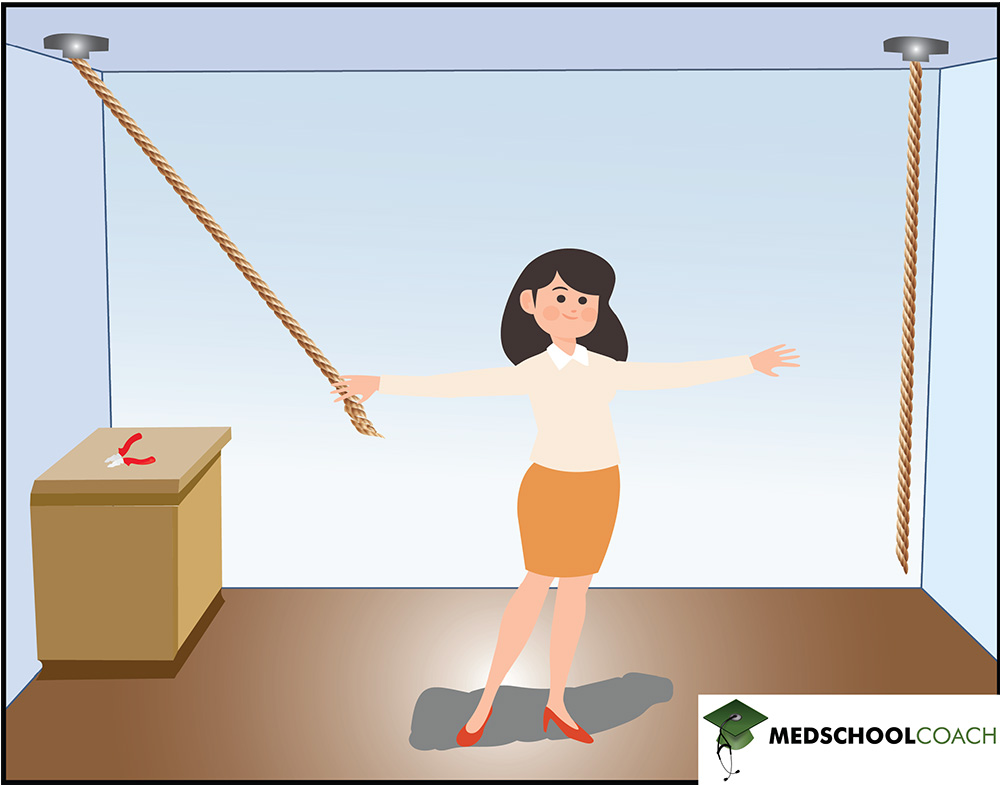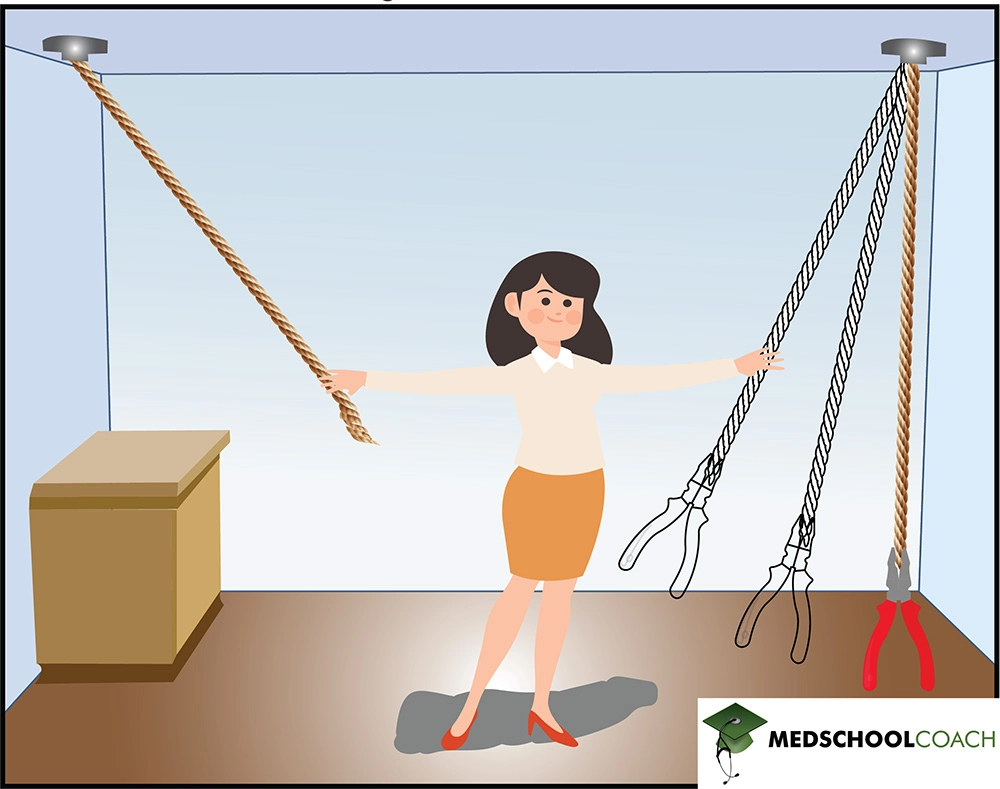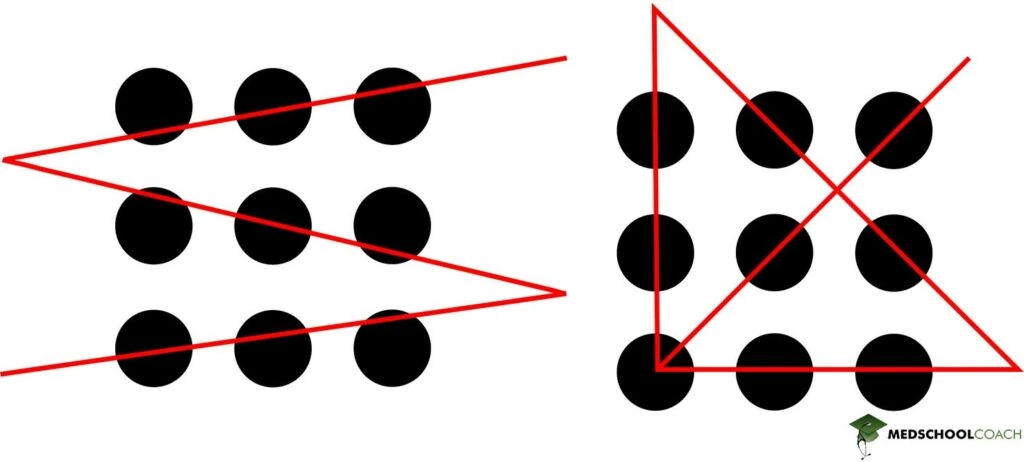Barriers to Effective Problem Solving
MCAT Psychology - Chapter 2- Section 4 - Cognition - Intelligence & Problem-Solving
- Home
- »
- MCAT Masterclass
- »
- Psychological, Social, and Biological Foundations of Behavior
- »
- Psychology
- »
- Cognition
- »
- Intelligence and Problem-Solving
- »
- Barriers to Effective Problem Solving – MCAT Psychology
Sample MCAT Question - Barriers to Effective Problem Solving
Which barrier to effective problem solving involves thinking that it is necessary to use all information provided to solve a problem?
a) Irrelevant Information
b) Functional Fixedness
c) Mental Set
d) Unnecessary Constraints
B is correct.
Confirmation bias is a type of cognitive bias that describes how individuals search for or interpret information in a way that confirms their preexisting beliefs. Searching for or placing more weight on evidence that supports your position is an example of this. Answer choice A is incorrect because anchoring bias is the tendency to rely on the first piece of information learned when making decisions. Answer choice C is incorrect because self-serving bias is when one attributes their own successes to internal abilities and efforts but failure to external factors. Answer choice D is incorrect because fundamental attribution error is the tendency to attribute others failures to internal factors and their successes to external factors.
Conciousness-Altering Drugs
Get 1-on-1 MCAT Tutoring From a Specialist
With MCAT tutoring from MedSchoolCoach, we are committed to help you prepare, excel, and optimize your ideal score on the MCAT exam.
For each student we work with, we learn about their learning style, content knowledge, and goals. We match them with the most suitable tutor and conduct online sessions that make them feel as if they are in the classroom. Each session is recorded, plus with access to whiteboard notes. We focus on high-yield topics if you’re pressed for time. If you have more time or high-score goals, we meticulously cover the entire MCAT syllabus.
Barriers to Effective Problem Solving for the MCAT
In the MCAT post, we explore four barriers to effective problem solving that are important to know for the Psychological, Social, and Biological Foundations of Behavior section of the MCAT. These four barriers are irrelevant information, functional fixedness, mental set, and unnecessary constraints.
Irrelevant Information
Irrelevant information is information included in a problem that is not related to or required to solve the problem. Irrelevant information is an issue because people generally believe that they need to use all the information provided in a problem to solve it. However, this is often not the case. To solve problems efficiently, it is necessary to determine what information is relevant.
Consider the problem: 30% of residents in Boston have unlisted telephone numbers. If you randomly select 150 names from the Boston telephone directory, how many of these people would you expect to have unlisted phone numbers? In this problem, the information provided is that 30% of residents have unlisted phone numbers, and 150 names are selected from the Boston telephone book. It can be tempting to think that the answer is just 30% of 150 people (45 people). However, this is not correct. The answer to this problem is actually zero because names taken from a telephone directory must have listed numbers. The 30% is a distractor in the problem and is not required to answer the question.
Functional Fixedness
Functional fixedness is the tendency to perceive objects only in terms of their most common uses. For example, in the String Problem depicted in Figure 1, two strings hang from a ceiling and need to be tied together. However, they are too far apart to allow a person to grab one and walk to the other. On the table is a pair of pliers. Most people can’t determine how to utilize the pliers to tie the two strings together because they think of the pliers as a tool to hold, bend, or compress objects.

However, in the solution depicted in Figure 2, it can be seen that there are other ways to use pliers. The pliers can be connected to the string to make a pendulum and swung back and forth to allow someone holding one string to grab the other. By surpassing functional fixedness and being able to utilize objects in less common ways, problem-solving can be made easier.

Mental Set
A mental set is the collection of problem-solving strategies that have worked for a person in the past. Take the Water Jar Problem as an example, where there are three empty water jars that can hold different volumes of fluids. Jar A can hold 37 cups of water, Jar B can hold 12 cups of water, and Jar C can hold five cups of water. The problem’s task involves filling and emptying the jars as many times as necessary to measure out 10 cups of water. The solution is to fill up Jar A with 37 cups of water. This is poured into Jar B, which removes 12 cups of water and leaves 25 cups of water in Jar A. Jar A is then poured into Jar C to remove five cups of water. This is done three times to remove 15 cups of water, leaving 10 cups of water in Jar A.
In trial two of the Water Jar Problem, Jar A can hold 43 cups of water, Jar B can hold nine cups of water, and Jar C can hold four cups of water. The goal is to measure out 22 cups of water. When presented with this problem, most people want to try the same solution that worked for trial one of the problems, allowing them to solve trial two faster. If Jar A is filled with 43 cups of water and poured into Jar B, nine cups of water will be removed, leaving 34 cups in Jar A. If Jar A is poured into Jar C three times, it will get rid of 12 total cups of water, resulting in 22 cups in Jar A.
Trial three of this problem is solved in the same way, and people solve trial three even quicker than the first two trials. Jar A holds 24 cups of water, Jar B holds four cups of water, and Jar C holds three cups of water. The goal is to measure out 11 cups of water. Jar A is filled with 24 cups of water and poured into Jar B to get rid of four cups of water. The remaining 20 cups of water in Jar A is poured into Jar C three times to get rid of nine total cups of water, resulting in the final goal of 11 cups of water.
In trial four of this problem, Jar A can hold 35 cups of water, Jar B can hold 13 cups of water, and Jar C four cups of water with the final goal of having nine cups of water. This is the easiest of the trials. However, after solving the first three trials, most people have a long, difficult time solving this one. This is because they attempt to solve it with the same strategy that worked for the last three trials, filling Jar A with 35 cups of water, pouring it into Jar B to yield 22 cups of water, and then pouring it into Jar C three times. However, this leaves Jar A with 10 cups of water, which is not the goal volume. The answer is simple and involves filling Jar B with 13 cups of water and pouring four cups out into Jar C to end with nine cups of water. Despite this being the simplest trial, mental set causes many to struggle to solve it.
Unnecessary Constraints
An unnecessary constraint is another barrier to effective problem solving and occurs when individuals assume that there are rules that don’t actually exist. For example, in the problem depicted in Figure 1, nine circles need to be connected using four lines. The unnecessary constraint that most people believe is that there is a barrier around the circles that can’t be crossed. With this unnecessary constraint, drawing four lines to connect the nine circles is impossible. However, without this unnecessary constraint, there are several possible solutions, two of which are depicted, demonstrating how problem-solving can be made easier by removing unnecessary constraints.

To surpass barriers to effective problem solving, such as mental set and unnecessary constraints, it is necessary to think outside of the box and not be restricted to past strategies or constraints that don’t actually exist.
Explore More MCAT Masterclass Chapters
Take a closer look at our entire MCAT Masterclass or explore our Biochemistry lessons below.

One-on-One Tutoring
Are you ready to take your MCAT performance to a whole new level? Work with our 99th-percentile MCAT tutors to boost your score by 12 points or more!
See if MCAT Tutoring can help me
Talk to our enrollment team about MCAT Tutoring

MCAT Go Audio Course
Engaging audio learning to take your MCAT learning on the go, any time, any where. You'll be on the way to a higher MCAT score no matter where you are. Listen to over 200+ lessons.

MCAT Practice Exams
Practice makes perfect! Our mock exams coupled with thorough explanations and in-depth analytics help students understand exactly where they stand.

MCAT Prep App
Access hundreds of MCAT videos to help you study and raise your exam score. Augment your learning with expert-created flashcards and a question banks.